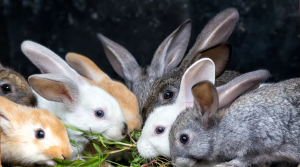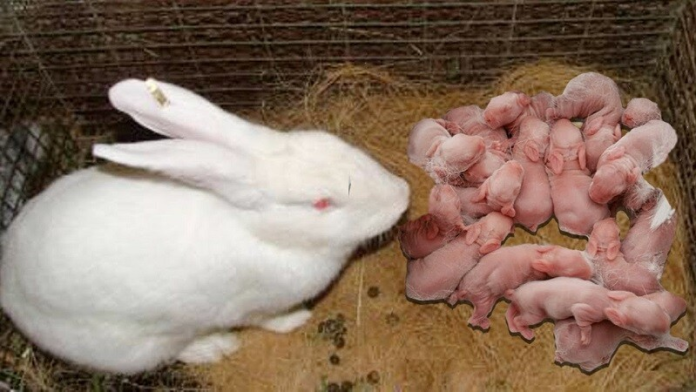How Many Rabbits in a Litter
The number of rabbits in a litter can vary depending on the breed of the rabbit, the age of the mother, and other factors. On average, domestic rabbits typically have litters ranging from 4 to 12 kits (baby rabbits). However, some larger breeds may have smaller litters, while smaller breeds might have larger litters.
Rabbits are known for their rapid reproduction rate, making them popular subjects of curiosity for many animal enthusiasts. The question “How many rabbits in a litter” often arises when discussing these adorable and prolific creatures. In this article, we’ll delve into the fascinating world of rabbit reproduction, exploring the factors that influence litter size, the breeding process, and the significance of understanding these aspects for rabbit caretakers.
Rabbit Reproduction: An Overview
Rabbit reproduction is a marvel of nature’s efficiency. Female rabbits, known as does, have the ability to reproduce from a very young age. Male rabbits, or bucks, play their part in the process by fertilizing the eggs produced by the does. This leads us to the question: How many rabbits in a litter?
Factors Affecting Litter Size
Genetic Factors
Genetics play a significant role in determining litter size. Different rabbit breeds have varying capacities for reproduction. Some breeds are known for larger litters, while others may have smaller ones. Additionally, the genetic history of individual rabbits can influence their reproductive potential.
Environmental Conditions
The environment in which rabbits are kept can also impact litter size. Rabbits that are well-nourished and provided with optimal living conditions are more likely to have larger litter. Factors such as stress and inadequate nutrition can lead to smaller litters or even hinder reproduction altogether. Discover more about coffee Does Coffee Ice Cream Have Caffeine: Yes or No
The Breeding Process
Mating Behavior
Rabbits are known for their unique mating behaviors. When a doe is receptive, she will entice the buck through various actions. Once the mating is successful, fertilization occurs, and the development of the litter begins.
Gestation Period
The gestation period for rabbits is relatively short, lasting about 28 to 31 days. During this time, the embryos develop within the doe’s womb, getting ready for birth.
Nesting and Kindling
As the due date approaches, the doe exhibits nesting behavior. She gathers hay and other materials to create a warm and cozy nest for her soon-to-arrive offspring. When the time comes, she gives birth, a process referred to as kindling.
Litter Size Variations
Rabbit Breed Differences
Different rabbit breeds have distinct average litter sizes. Some may give birth to just a few kits, while others might have larger litters. It’s important to research the breed’s typical reproductive characteristics if you’re a breeder or considering adopting a rabbit.
First-Time vs. Experienced Does
First-time mothers may have slightly smaller litters compared to ones that have kindled before. Experience can often result in more successful pregnancies and larger litters.
Read more about Does Coffee Ice Cream Have Caffeine: Yes or No
Caring for Rabbit Litters
Providing Adequate Nesting Material
Ensuring that the doe has access to suitable nesting materials is crucial. A comfortable and secure nesting area can contribute to the survival and well-being of the newborn kits.
Monitoring the Doe and Litter
While rabbits are generally good mothers, monitoring the doe and her litter is essential, especially during the first few days. This helps ensure that all kits are nursing and growing properly.

Providing Proper Nutrition for Pregnant Does
Ensuring the proper nutrition of pregnant does is vital for the health of both the mother and her litter. During pregnancy, the doe’s nutritional needs increase significantly. High-quality hay, fresh vegetables, and specially formulated rabbit pellets should be the foundation of her diet. Providing ample fresh water is also crucial, as it supports milk production and overall well-being.
Managing the Nesting Environment
Creating a suitable nesting environment for the pregnant doe is essential for the well-being of the upcoming litter. A nesting box placed within her enclosure provides privacy and security for the doe to give birth comfortably. The nesting box should be lined with soft materials like hay and straw to keep the kits warm and cozy. The moment of kindling, when the doe gives birth to her kits, is a remarkable process to witness. Newborn kits are born blind, naked, and entirely dependent on their mother. Over the next few weeks, they will develop rapidly, growing fur and opening their eyes by around two weeks of age.
Early Days of Kit Development
During the first week of life, kits rely solely on their mother’s milk for sustenance. Rabbit milk is highly nutritious, providing the essential nutrients needed for growth. The mother’s milk also contains antibodies that boost the kits’ immune systems, helping them ward off potential illnesses.
As the kits grow and develop, they begin to show interest in solid foods around three weeks of age. This marks the beginning of the weaning process, during which the kits transition from relying solely on their mother’s milk to consuming solid foods. At around eight weeks of age, kits are typically weaned and ready to be separated from their mother.
Bonding with Baby Rabbits
Bonding with baby rabbits is a delightful and rewarding experience. Spending time near the enclosure, talking softly, and offering treats can help the kits become familiar with your presence. This early socialization can contribute to friendly and well-adjusted adult rabbits.

Conclusion
Understanding how many rabbits in a litter involves exploring various factors, from genetics to environmental conditions. As rabbit enthusiasts, breeders, or pet owners, this knowledge enhances our ability to care for these charming animals and ensure their well-being. By appreciating the intricacies of rabbit reproduction, we can create better lives for these furry companions.
FAQs
What Should I Do if the Doe Rejects Her Litter?
If a doe rejects her litter, it’s best to consult a veterinarian or an experienced rabbit breeder for guidance. They can provide advice on how to care for the abandoned kits.
How Soon Can a Doe Get Pregnant Again After Kindling?
Doe rabbits can become pregnant shortly after giving birth. However, it’s recommended to allow the doe some time to recover before considering another pregnancy.
Is It Necessary to Separate Buck and Doe After Mating?
Separating the buck and doe after mating is generally a good practice. This prevents accidental re-mating and allows the doe a peaceful pregnancy.
How Long Should I Wait Before Handling the Newborn Rabbits?
Newborn rabbits are delicate, and excessive handling in the early days can be stressful for them. It’s best to minimize contact for the first week or so.
What If the Litter Size Seems Abnormally Large or Small?
If you’re concerned about the size of the litter, it’s advised to seek professional guidance. A veterinarian can assess the situation and provide insights based on the specific circumstances.




